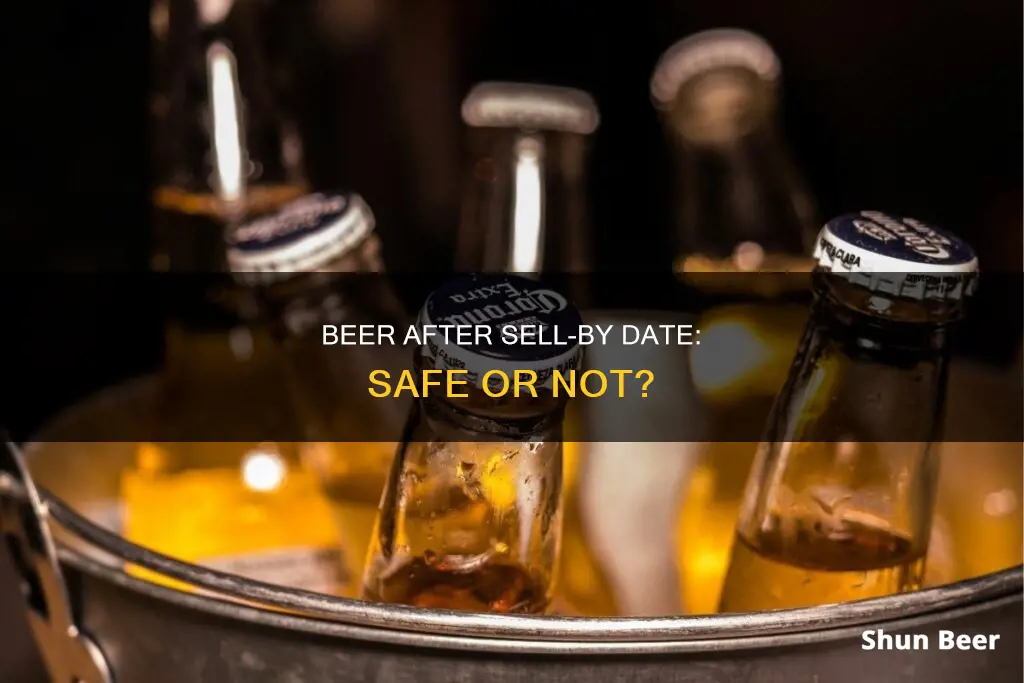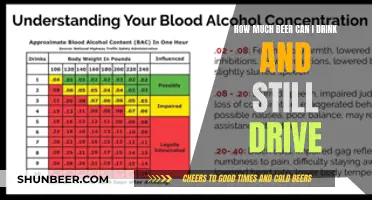
Beer is often labelled with a 'best before' date, which is a guideline on quality rather than safety. This means that the beer will start to lose its quality after the stated date, but it is still safe to drink. The taste of the beer will deteriorate over time, and how you store your beer will also affect the taste. Beer is very sensitive to light and dramatic temperature changes. It is best to store beer in a cool, dark place to avoid it going skunking.
The bottom line is that drinking beer past its best before date is not unsafe, but it might not taste very good.
| Characteristics | Values |
|---|---|
| Is it safe to drink beer after the sell-by date? | Beer has no 'use by' date, and it is safe to drink well past the best-before date. |
| How does beer taste after the sell-by date? | The taste of the beer will deteriorate over time. |
| How long does beer last past its best-before date? | A standard light lager will last around 6 months to 2 years after the best-before date if kept in the fridge, and 6-9 months if kept in the cupboard. |
| How to store beer? | Beer should be stored in a cool, dark place to avoid the beer "skunking". |
What You'll Learn

Beer's 'best before' date is a guideline, not a rule
Beers with a 'best before' date are safe to drink after this date passes. This is because the date is more of a guideline on quality, rather than a rule on safety. The beer will not be harmful to consume, but it may not taste as good. The flavour will deteriorate over time, and the beer may become flat.
The length of time that a beer remains drinkable after its 'best before' date depends on the type of beer and how it is stored. A typical lager will be drinkable for 6–24 months after its best before date if kept in the fridge, and for up to 9 months if kept in a cool, dry place. Beers with a higher alcohol content, such as imperial stouts and porters, can be drinkable for 5–10 years or more. Beers that are unfiltered or unpasteurised will have a shorter shelf life, as they are unstable and deteriorate more quickly.
The best way to store beer is in a cool, dark place, ideally in the fridge. Beer is sensitive to light and temperature changes, which can cause it to develop a foul taste.
Is Expired Beer Safe to Drink?
You may want to see also

Beer won't be harmful past its 'best before' date, but it may taste bad
Beer has a 'best before' date, which is a guideline on quality rather than safety. This means that the beer will start to lose its quality after the stated date, but it is still safe to drink. Beer won't be harmful past its best-before date, but it may taste bad.
The taste of beer will deteriorate over time, and how you store your beer will also affect the taste. Beer is very sensitive to light and dramatic temperature changes, so it should be stored in a cool, dark place to avoid it going "skunky".
The higher the alcohol content of the beer, the less you need to be concerned with the use-by date. Beers with higher alcohol content, such as imperial stouts and porters, can last for 5-10 years or more. Beers with lower alcohol content, such as lagers, IPAs, and pale ales, will normally last around 6 months to 2 years after the best-before date if kept in the fridge, and 6-9 months if kept in the cupboard.
Some beers are created with ageing in mind, and can actually taste better over time. These tend to be high-alcohol beers, such as barley wines, porters, and imperial stouts, and beers made with organisms other than yeast to produce flavours, such as lambics, gueuzes, and saisons. These beers can be aged like wine in cellars or places that emulate the cool, dark conditions of cellars.
Drinking Beer and Driving: Is It Safe?
You may want to see also

Beer should be stored in a cool, dark place
The ideal temperature for storing beer is between 2°C and 7°C. Beer should never be stored above room temperature. If you buy beer from the supermarket fridge, it should be kept in the fridge at home, as fluctuations in temperature may affect it.
If you don't have space in your fridge, beer should be stored in a cool, dry place, out of direct sunlight.
Beer Drinking: Is Daily Consumption Really That Bad?
You may want to see also

Beer in clear bottles is more likely to have a skunky taste
Drinking beer after its sell-by date is generally safe, but the taste may be affected. Beer stored in clear bottles is more likely to have a skunky taste due to exposure to light.
Beer in clear bottles is more susceptible to developing a skunky taste due to the chemical reaction that occurs when ultraviolet (UV) light interacts with the bitter hop compounds in the brew. This reaction results in the creation of 3-methylbut-2-ene-1-thiol (3-MBT), a compound that humans are remarkably good at detecting. Even a few parts per trillion of 3-MBT can be noticeable, making it one of the most powerful flavours in beer.
The type of glass used in bottling beer plays a crucial role in preventing the skunky taste. Brown glass bottles block much more light and are superior to clear or green glass bottles in protecting the beer from UV exposure. Cans and kegs are even better as they block out all light.
Some breweries continue to use clear or green glass bottles for their beer, despite the potential for skunkification. This may be due to nostalgia, as consumers associate the taste of skunked beer with certain brands, such as Corona. Additionally, during World War II, there was a shortage of brown glass, forcing European brewers to use clear or green glass bottles. The green glass bottles became associated with higher-quality beer, and the tradition has persisted for aesthetic and marketing purposes.
In summary, while drinking beer after its sell-by date is generally safe, the taste may deteriorate over time. Beer stored in clear bottles is particularly vulnerable to developing a skunky taste due to UV light exposure, which triggers a chemical reaction with the hop compounds in the beer. To prevent this, brown glass bottles, cans, or kegs are recommended to block the specific wavelengths of light that cause the skunky flavour. However, some breweries continue to use clear or green glass bottles due to brand recognition and historical reasons.
Beer and Surgery: What's Safe and What's Not?
You may want to see also

Beers with higher alcohol content tend to last longer
Beer typically has a 'best before' date, which is more of a guideline on quality than safety. The alcohol content, type of beer, and storage conditions all influence how long a beer will last beyond its 'best before' date. Beers with higher alcohol content tend to last longer and certain varieties, such as porters and stouts, can improve with age if stored properly.
The 'best before' date indicates when a beer will start to lose its quality. However, this does not mean that the beer will become unsafe to drink. The alcohol and hops in beer act as preservatives, preventing pathogenic bacterial growth. As a result, the worst thing that will happen to old beer is that its flavour will deteriorate over time.
Beers with higher alcohol content tend to have a longer shelf life. High-alcohol, malt-forward styles, such as barley wines and imperial stouts, are sometimes brewed with aging in mind. These beers can be cellared for a couple of years and may even improve with age.
The type of beer also plays a role in how long it will last. IPAs, for example, are best consumed sooner rather than later as they gradually lose their flavour and aroma. On the other hand, speciality beers like lambics and saisons can change flavour over time as the yeasts used in their production continue to live in the beer for years.
Storage conditions also impact how long a beer will last. Refrigeration can extend the shelf life of beers, with a typical lager lasting 6-24 months past its 'best before' date if kept chilled. Additionally, storing beer in a cool, dark place like a basement or cellar can help maintain its quality.
In summary, beers with higher alcohol content tend to have a longer shelf life and can even improve with age when stored properly. However, the type of beer and storage conditions also play a significant role in how long a beer will last beyond its 'best before' date.
Beer and Wheat Belly Diet: What You Need to Know
You may want to see also
Frequently asked questions
Beer has a 'best before' date, which is a guideline on quality rather than safety. Beer won't be dangerous to drink past this date, but the taste will deteriorate over time.
This depends on the type of beer and how it is stored. A standard light lager will last around 6 months to 2 years after its best-before date if kept in the fridge, and 6-9 months if kept in the cupboard.
There will be a bad aroma, and it may be missing the usual 'pssst' sound and foaming when you open it. You could also look at the bottom of the bottle for excessive sediment.







